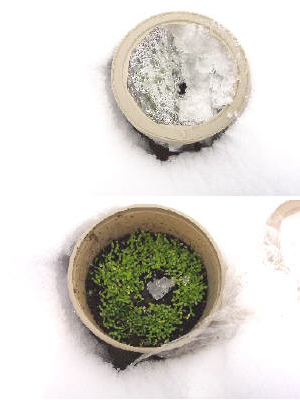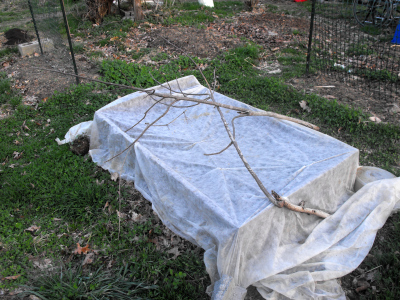
Winter sowing vs. cold frames
 While
I'm on the subject of techniques that I consider to be overhyped, I
can't resist a post about winter sowing. According to the
official website, "Winter Sowing is done outdoors during Winter using
mini-greenhouses
made from recyclables; there are no heating devices, no energy wasting
light set-ups or expensive seed starting devices."
While
I'm on the subject of techniques that I consider to be overhyped, I
can't resist a post about winter sowing. According to the
official website, "Winter Sowing is done outdoors during Winter using
mini-greenhouses
made from recyclables; there are no heating devices, no energy wasting
light set-ups or expensive seed starting devices."
Just take a container
and turn it into a pot by poking
a few holes in the bottom. Then put in your soil, drop in some
seeds, and cover the pot with a clear plastic lid doctored with a few
slits. The container acts like a mini greenhouse and germinates
the seeds a few weeks before they would germinate if sown directly into
the
garden.
Winter sowing is
basically a replacement for the easy-to-do-wrong method of starting
your seedlings on a sunny windowsill or under grow lights.
Beginning gardeners often fall into a couple of traps when using the
windowsill method, both of which result in leggy seedlings that
transplant badly --- they usually can't get enough light to their
plants, and they start the seedlings too early. Damping off is
another potential problem since moist potting soil tends to grow a
nasty fungus that will kill your seedlings. Then, when you bring
your remaining seedlings outside to plant in the garden, they have a
severe shock --- they're used to the climate-controlled conditions
inside your house, so unless you slowly harden them off, many will die.
 But
while winter sowing is preferable to starting seeds inside, I think
that a cold frame is even better. Like winter sowing, it gives
your seeds a few weeks' head start, but the cold frame provides more
protection from freezing temperatures since the seedlings are in direct
contact with the temperature-mitigating earth. Your seedlings
have more room to spread their roots through the soil, ensuring a
healthy plant, and the permeable row cover fabric I use to cover the
frames ensures that you don't have to water your seedlings or worry
about them overheating.
But
while winter sowing is preferable to starting seeds inside, I think
that a cold frame is even better. Like winter sowing, it gives
your seeds a few weeks' head start, but the cold frame provides more
protection from freezing temperatures since the seedlings are in direct
contact with the temperature-mitigating earth. Your seedlings
have more room to spread their roots through the soil, ensuring a
healthy plant, and the permeable row cover fabric I use to cover the
frames ensures that you don't have to water your seedlings or worry
about them overheating.
Over the last few years,
I've tried starting seeds both indoors under a grow light and outdoors
in these cold frames and I've decided that the cold frame is preferable
for lettuce, cabbage, broccoli, and tomatoes. On the other hand,
peppers are just too tender --- they came up no sooner in a cold frame
than when directly sowed in the ground, so I'm starting a few indoors
this year. Read my post about how to build a cold frame for a couple of dollars
worth of screws and give it a shot --- I suspect you'll never go back
to either windowsill starting or winter sowing.
| This post is part of our Square Foot Gardening lunchtime series.
Read all of the entries: |
Want more in-depth information? Browse through our books.
Or explore more posts by date or by subject.
About us: Anna Hess and Mark Hamilton spent over a decade living self-sufficiently in the mountains of Virginia before moving north to start over from scratch in the foothills of Ohio. They've experimented with permaculture, no-till gardening, trailersteading, home-based microbusinesses and much more, writing about their adventures in both blogs and books.
Want to be notified when new comments are posted on this page? Click on the RSS button after you add a comment to subscribe to the comment feed, or simply check the box beside "email replies to me" while writing your comment.

Mitsy --- I mostly direct-sow, but I start tomatoes, broccoli, and cabbages under quick hoops. This year, I think I'm going to start peppers inside --- Mark was really keen on the sweet peppers last year, and if you want them early, you need to start them inside. (They're even less cold-hardy than tomatoes.) I'll probably start a few tomatoes inside while I'm at it, even though the quick-hoop ones usually catch up to the inside-started tomatoes pretty quickly. I haven't quite decided about onions --- I think I might start them inside and transplant, but they do well under quick hoops too if you have enough.
If you don't have grow lights, I think the biggest mistake most people make is to start seeds too early. Did you download the garden spreadsheet I linked to in this post? It has all my planting dates along with which ones are indoors and in quick hoops. I hope that helps!